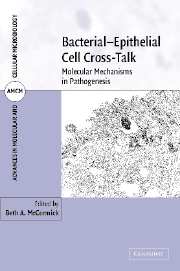Book contents
- Frontmatter
- Contents
- List of contributors
- Part I Introduction to the host and bacterial pathogens
- Part II Bacterial cell biology and pathogenesis
- Part III Host cell signaling by bacteria
- 8 Host-mediated invasion: the Salmonella Typhimurium trigger
- 9 NF-κB-dependent responses activated by bacterial–epithelial interactions
- 10 NF-kB-independent responses activated by bacterial–epithelial interactions: the role of arachidonic acid metabolites
- Part IV Exploitation of host niches by pathogenic bacteria: mechanisms and consequences
- Index
- Plate section
- References
9 - NF-κB-dependent responses activated by bacterial–epithelial interactions
from Part III - Host cell signaling by bacteria
Published online by Cambridge University Press: 12 August 2009
- Frontmatter
- Contents
- List of contributors
- Part I Introduction to the host and bacterial pathogens
- Part II Bacterial cell biology and pathogenesis
- Part III Host cell signaling by bacteria
- 8 Host-mediated invasion: the Salmonella Typhimurium trigger
- 9 NF-κB-dependent responses activated by bacterial–epithelial interactions
- 10 NF-kB-independent responses activated by bacterial–epithelial interactions: the role of arachidonic acid metabolites
- Part IV Exploitation of host niches by pathogenic bacteria: mechanisms and consequences
- Index
- Plate section
- References
Summary
INTRODUCTION
The epithelial surfaces of the skin and the intestinal, respiratory, and reproductive tracts constitute the outer frontiers of the body and are exposed continuously to the myriad microorganisms present in the external environment. Like any good frontier guard, the cells of these epithelia must carry out two important functions – establish barriers against microbial intruders and raise the alarm if the barriers are breached. The nuclear factor kappa B (NF-κB) family of transcription factors plays a vital role in these functions by controlling the expression of a number of genes involved in antimicrobial defense and in the inflammatory response. Central to this role is the ability of NF-κB to be regulated by cellular signaling pathways that are activated by a wide variety of microorganisms. This sensitivity to microbial signals allows NF-κB function to be modulated appropriately in response to any changes in the flora that is in contact with the epithelium.
This chapter reviews what is currently known about the major NF-κB-dependent inflammatory responses elicited in mammalian epithelial cells as a result of interactions with bacteria. We start with an overview of the NF-κB family and its basic regulation. In subsequent sections, we discuss the mechanisms of modulation of NF-κB function by bacteria-derived signals, the consequent alterations in cell function, and the clinical abnormalities that can result from genetic defects in NF-κB activation.
- Type
- Chapter
- Information
- Bacterial-Epithelial Cell Cross-TalkMolecular Mechanisms in Pathogenesis, pp. 244 - 268Publisher: Cambridge University PressPrint publication year: 2006



